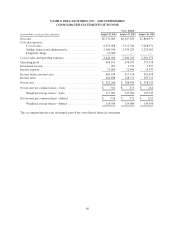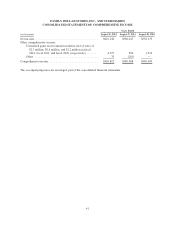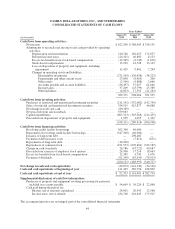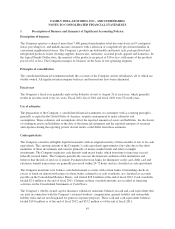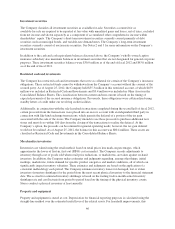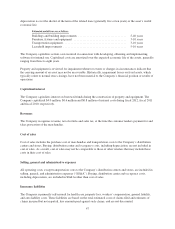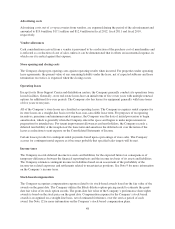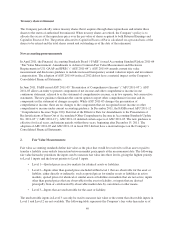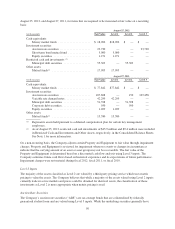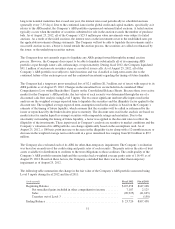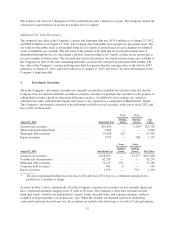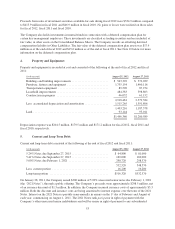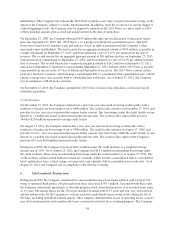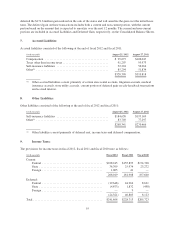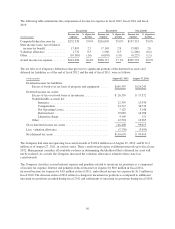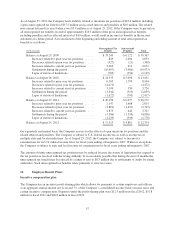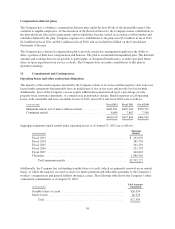Family Dollar 2012 Annual Report Download - page 53
Download and view the complete annual report
Please find page 53 of the 2012 Family Dollar annual report below. You can navigate through the pages in the report by either clicking on the pages listed below, or by using the keyword search tool below to find specific information within the annual report.Treasury share retirement
The Company periodically retires treasury shares that it acquires through share repurchases and returns those
shares to the status of authorized but unissued. When treasury shares are retired, the Company’s policy is to
allocate the excess of the repurchase price over the par value of shares acquired to both Retained Earnings and
Capital in Excess of Par. The portion allocated to Capital in Excess of Par is calculated on a pro-rata basis of the
shares to be retired and the total shares issued and outstanding as of the date of the retirement.
New accounting pronouncements
In April 2011, the Financial Accounting Standards Board (“FASB”) issued Accounting Standard Update 2011-04
“Fair Value Measurement: Amendments to Achieve Common Fair Value Measurement and Disclosure
Requirements in U.S. GAAP and IFRSs” (“ASU 2011-04”). ASU 2011-04 amends current fair value
measurement and disclosure guidance to include increased transparency around valuation inputs and investment
categorization. The adoption of ASU 2011-04 in fiscal 2012 did not have a material impact on the Company’s
Consolidated Financial Statements.
In June 2011, FASB issued ASU 2011-05 “Presentation of Comprehensive Income” (“ASU 2011-05”). ASU
2011-05 allows an entity to present components of net income and other comprehensive income in one
continuous statement, referred to as the statement of comprehensive income, or in two separate, but consecutive
statements. The new guidance eliminates the current option to report other comprehensive income and its
components in the statement of changes in equity. While ASU 2011-05 changes the presentation of
comprehensive income, there are no changes to the components that are recognized in net income or other
comprehensive income under current accounting guidance. In December 2011, the FASB issued ASU 2011-12
“Comprehensive Income (Topic 220): Deferral of the Effective Date for Amendments to the Presentation of
Reclassifications of Items Out of Accumulated Other Comprehensive Income in Accounting Standards Update
No. 2011-05” (“ASU 2011-12”). ASU 2011-12 deferred certain aspects of ASU 2011-05. The new guidance is
effective for fiscal years, and interim periods within those years, beginning after December 15, 2011. The
adoption of ASU 2011-05 and ASU 2011-12 in fiscal 2012 did not have a material impact on the Company’s
Consolidated Financial Statements.
2. Fair Value Measurements:
Fair value accounting standards define fair value as the price that would be received to sell an asset or paid to
transfer a liability in an orderly transaction between market participants at the measurement date. The following
fair value hierarchy prioritizes the inputs used to measure fair value into three levels, giving the highest priority
to Level 1 inputs and the lowest priority to Level 3 inputs.
• Level 1—Quoted prices in active markets for identical assets or liabilities.
• Level 2—Inputs other than quoted prices included within Level 1 that are observable for the asset or
liability, either directly or indirectly, such as quoted prices for similar assets or liabilities in active
markets, quoted prices for identical or similar assets or liabilities in markets that are not active, inputs
other than quoted prices that are observable for the asset or liability, or inputs that are derived
principally from or corroborated by observable market data by correlation or other means.
• Level 3—Inputs that are unobservable for the asset or liability.
The unobservable inputs in Level 3 can only be used to measure fair value to the extent that observable inputs in
Level 1 and Level 2 are not available. The following table represents the Company’s fair value hierarchy as of
49



